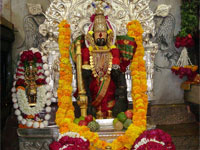

Muktinath is one of the major Vaishnav temples. The pilgrimage place here is famous for Lord Shaligram. Shaligram is a sacred stone which is considered special in Hindu religion. The main source here is considered to be the Kali Ganga river flowing from Nepal. This area is known as 'Muktikshetra', according to Hindu religion liberation or moksha is attained here. It is difficult for travelers to reach Muktinath, yet a large number of Hindu devotees come here for pilgrimage. In the journey one has to cross many large parts of the Himalayan Mountains. It is considered one of the remote pilgrimage places of Hinduism.
Muktinath, situated in the Muktinath Valley at the base of the Thorong La mountain pass in Mustang, Nepal, serves as a revered Vishnu temple. This sacred site holds profound significance for both Hindus and Buddhists, standing at an elevation of 3,800 meters as one of the world's highest temples.
In Hinduism, Muktinath ranks among the 108 Divya Desams, uniquely positioned as the sole Divya Desam located outside India. Referred to as Mukti Kshetra, meaning the 'arena of liberation' or moksha, it also holds a place among Nepal's Char Dham.
Considered the 106th of the 108 Divya Desam, this temple holds immense sanctity within the Sri Vaishnava sect and is known in their ancient literature as Tiru Shaligramam. The nearby Gandaki river is venerated as the sole source of the shaligrama shila, the symbolic non-anthropomorphic representation of Vishnu.
For Buddhists, Muktinath bears the name Chumig Gyatsa, translating to "Hundred Waters" in Tibetan. It stands as a significant place for dakinis, revered goddesses known as Sky Dancers, and ranks among the 24 Tantric places. Tibetan Buddhists perceive the murti at Muktinath as a manifestation of Avalokiteśvara, embodying the compassion of all Buddhas.
Shree Muktinath Temple, revered as the "Mukti Kshetra," holds a divine allure for Hindu devotees. Believed to be a place of salvation, devotees undertake arduous journeys, traversing rugged terrains and navigating through the Annapurna Circuit, to reach this sacred destination. Once arrived, they immerse themselves in rituals, bathing in the holy waters that flow within the temple complex, seeking blessings for spiritual emancipation. The temple is dedicated to Lord Vishnu and encompasses a profound aura of tranquility and piety.
Downstream from Muktinath along the Kali Gandaki river lies the origin of shilas or shaligramas, essential for consecrating Vishnu temples. This location holds profound importance as a pilgrimage site cherished by both Hindus and Buddhists.
The site boasts 108 water springs, a number of considerable significance in Hindu philosophy. For instance, Hindu astrology underscores the significance of 108 as it encompasses 12 zodiacs (rashi) and nine planets (navagraha), amounting to a total of 108 combinations. Moreover, the 27 lunar mansions (nakshatras), divided into four quarters (padas), contribute to a collective sum of 108 padas, highlighting the mystique surrounding this number.
What makes Shree Muktinath Temple unique is its harmonious fusion of Hindu and Buddhist reverence. For Buddhists, this site holds immense significance as Chumig Gyatsa, a revered place of Dakinis and one of the 24 Tantric places. The temple complex reflects this synthesis, adorned with shrines and statues dedicated to both Hindu deities, like Lord Vishnu, and Buddhist figures, symbolizing the coexistence and harmony between these two faiths.
Beyond its spiritual significance, the temple's setting amidst the Himalayas elevates its allure. The journey to Muktinath often involves trekking through awe-inspiring landscapes, embracing the serenity of the mountains, and encountering the raw beauty of nature. Pilgrims and trekkers alike are rewarded not only with spiritual fulfillment but also with panoramic vistas that captivate the soul.
A distinctive feature of Muktinath is the perpetually burning natural gas jets surrounding the temple. These eternal flames hold profound symbolism for devotees and visitors, who collect the sacred flame as a blessing, believing in its spiritual potency.
There's no need for visas for Indians. However, travelers using air routes must provide voter identification or PAN cards. Indian currency is widely accepted. However, carrying notes over 100 rupees is prohibited. Exchange facilities are available. 160 Nepalese rupees are given in exchange for 100 Indian rupees.
Regular flights operate from Delhi to Kathmandu. Additionally, there are regular flights from Kolkata, Varanasi, Bangalore, and Patna. Travel by road is also possible from Delhi and Kolkata, taking about 8-10 hours. Nepal's Birganj Raxaul is nearby. From there, it's a short 30-minute flight to Kathmandu. Travel from Gorakhpur to Kathmandu is also possible.
Pokhara is termed the 'gateway' to Muktinath, centrally located in Nepal. It's advised for visitors to first arrive in Kathmandu and then travel to Pokhara via road or air. From there, one must head to Jomsom. Helicopter or flight services are available from Jomsom to Muktinath. Travelers can also opt for bus transportation. The road journey covers a distance of about 200 km from Pokhara to Muktinath, taking approximately 8-9 hours, while travel by pony is also an option.